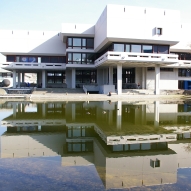Zusammenfassung
Objectives: This study investigated the in-vitro performance and fracture force of anterior implant-supported tooth-coloured fixed dental prosthesis (FDPs). Different material types with varying flexural strength and modulus of elasticity were compared with screw-retained or bonded application. Materials and methods: Identical anterior FDPs (tooth 11-13; n = 80) from materials (flexural strength ...
Zusammenfassung
Objectives: This study investigated the in-vitro performance and fracture force of anterior implant-supported tooth-coloured fixed dental prosthesis (FDPs). Different material types with varying flexural strength and modulus of elasticity were compared with screw-retained or bonded application. Materials and methods: Identical anterior FDPs (tooth 11-13; n = 80) from materials (flexural strength 240-1150 MPa, modulus 7.6-210 GPa; 1x lithiumdisilicate ceramic, 2x zirconia (4Y-TZP, 5Y-FSZ), 3x resin-Based composites (with different flexural strength and modulus)) were milled. FDPs were grouped into chairside (bonded) and labside (screw-retained) procedure. To simulate a 5-year clinical application, thermal cycling with mechanical loading (TCML) was accomplished. TCML-performance and fracture force were evaluated and failure patterns were analysed. Data were statistically investigated (Kolmogorov-Smirnov-test, one-way-ANOVA; posthoc-Bonferroni, alpha = 0.05). Results: TCML did not lead to any cracks, fractures or chipping on all tested FDPs. Fracture values varied between 1208.9 +/- 354.6 N (experimental resin-based composite) and 2094.3 +/- 293.4 N (4Y-TZP) for FDPs without screw channel. With screw channel the results ranged between 1297.9 +/- 268.3 N (5Y-FSZ) and 2129.3 +/- 321.7 N (4Y-TZP). The influence of the screw channel was not significant for all materials (p >= 0.218). Modulus of elasticity and flexural strength had influence on the fracture force only in the individual material groups. Fractures at the connector were predominant for ceramic and zirconia. Resin-based composites primarily showed radial fractures in abutment region or mixed failure types. FDPs with/without screw-channel showed comparable types of failure. Conclusions: TCML did not lead to drop-outs or failures for all FDPs. Individual materials showed no different in-vitro performance, but varying fracture force after TCML. Independent from material, screw channels did not weaken the FDPs. All tested systems showed sufficient properties for an anterior implant application.





 Altmetric
Altmetric